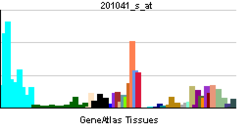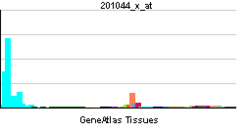- DUSP1
-
Dual specificity protein phosphatase 1 is an enzyme that in humans is encoded by the DUSP1 gene.[1][2]
The expression of DUSP1 gene is induced in human skin fibroblasts by oxidative/heat stress and growth factors. It specifies a protein with structural features similar to members of the non-receptor-type protein-tyrosine phosphatase family, and which has significant amino-acid sequence similarity to a Tyr/Ser-protein phosphatase encoded by the late gene H1 of vaccinia virus. The bacterially expressed and purified DUSP1 protein has intrinsic phosphatase activity, and specifically inactivates mitogen-activated protein (MAP) kinase in vitro by the concomitant dephosphorylation of both its phosphothreonine and phosphotyrosine residues. Furthermore, it suppresses the activation of MAP kinase by oncogenic ras in extracts of Xenopus oocytes. Thus, DUSP1 may play an important role in the human cellular response to environmental stress as well as in the negative regulation of cellular proliferation.[3]
Interactions
DUSP1 has been shown to interact with MAPK14,[4][5] MAPK1[5][6] and MAPK8.[5]
References
- ^ Keyse SM, Emslie EA (Nov 1992). "Oxidative stress and heat shock induce a human gene encoding a protein-tyrosine phosphatase". Nature 359 (6396): 644–7. doi:10.1038/359644a0. PMID 1406996.
- ^ Martell KJ, Kwak S, Hakes DJ, Dixon JE, Trent JM (Jan 1995). "Chromosomal localization of four human VH1-like protein-tyrosine phosphatases". Genomics 22 (2): 462–4. doi:10.1006/geno.1994.1411. PMID 7806236.
- ^ "Entrez Gene: DUSP1 dual specificity phosphatase 1". http://www.ncbi.nlm.nih.gov/sites/entrez?Db=gene&Cmd=ShowDetailView&TermToSearch=1843.
- ^ Tanoue, T; Yamamoto T, Maeda R, Nishida E (Jul. 2001). "A Novel MAPK phosphatase MKP-7 acts preferentially on JNK/SAPK and p38 alpha and beta MAPKs". J. Biol. Chem. (United States) 276 (28): 26629–39. doi:10.1074/jbc.M101981200. ISSN 0021-9258. PMID 11359773.
- ^ a b c Slack, D N; Seternes O M, Gabrielsen M, Keyse S M (May. 2001). "Distinct binding determinants for ERK2/p38alpha and JNK map kinases mediate catalytic activation and substrate selectivity of map kinase phosphatase-1". J. Biol. Chem. (United States) 276 (19): 16491–500. doi:10.1074/jbc.M010966200. ISSN 0021-9258. PMID 11278799.
- ^ Calvisi, Diego F; Pinna Federico, Meloni Floriana, Ladu Sara, Pellegrino Rossella, Sini Marcella, Daino Lucia, Simile Maria M, De Miglio Maria R, Virdis Patrizia, Frau Maddalena, Tomasi Maria L, Seddaiu Maria A, Muroni Maria R, Feo Francesco, Pascale Rosa M (Jun. 2008). "Dual-specificity phosphatase 1 ubiquitination in extracellular signal-regulated kinase-mediated control of growth in human hepatocellular carcinoma". Cancer Res. (United States) 68 (11): 4192–200. doi:10.1158/0008-5472.CAN-07-6157. PMID 18519678.
Further reading
- Martell KJ, Angelotti T, Ullrich A (1998). "The "VH1-like" dual-specificity protein tyrosine phosphatases". Mol. Cells 8 (1): 2–11. PMID 9571625.
- Keyse SM (1998). "Protein phosphatases and the regulation of MAP kinase activity". Semin. Cell Dev. Biol. 9 (2): 143–52. doi:10.1006/scdb.1997.0219. PMID 9599409.
- Abraham SM, Clark AR (2007). "Dual-specificity phosphatase 1: a critical regulator of innate immune responses". Biochem. Soc. Trans. 34 (Pt 6): 1018–23. doi:10.1042/BST0341018. PMID 17073741.
- Raingeaud J, Gupta S, Rogers JS et al. (1995). "Pro-inflammatory cytokines and environmental stress cause p38 mitogen-activated protein kinase activation by dual phosphorylation on tyrosine and threonine". J. Biol. Chem. 270 (13): 7420–6. doi:10.1074/jbc.270.13.7420. PMID 7535770.
- Kwak SP, Hakes DJ, Martell KJ, Dixon JE (1994). "Isolation and characterization of a human dual specificity protein-tyrosine phosphatase gene". J. Biol. Chem. 269 (5): 3596–604. PMID 8106404.
- Emslie EA, Jones TA, Sheer D, Keyse SM (1994). "The CL100 gene, which encodes a dual specificity (Tyr/Thr) MAP kinase phosphatase, is highly conserved and maps to human chromosome 5q34". Hum. Genet. 93 (5): 513–6. doi:10.1007/BF00202814. PMID 8168826.
- Sun H, Charles CH, Lau LF, Tonks NK (1993). "MKP-1 (3CH134), an immediate early gene product, is a dual specificity phosphatase that dephosphorylates MAP kinase in vivo". Cell 75 (3): 487–93. doi:10.1016/0092-8674(93)90383-2. PMID 8221888.
- Charles CH, Sun H, Lau LF, Tonks NK (1993). "The growth factor-inducible immediate-early gene 3CH134 encodes a protein-tyrosine-phosphatase". Proc. Natl. Acad. Sci. U.S.A. 90 (11): 5292–6. doi:10.1073/pnas.90.11.5292. PMC 46702. PMID 8389479. http://www.pubmedcentral.nih.gov/articlerender.fcgi?tool=pmcentrez&artid=46702.
- Alessi DR, Smythe C, Keyse SM (1993). "The human CL100 gene encodes a Tyr/Thr-protein phosphatase which potently and specifically inactivates MAP kinase and suppresses its activation by oncogenic ras in Xenopus oocyte extracts". Oncogene 8 (7): 2015–20. PMID 8390041.
- Brondello JM, Pouysségur J, McKenzie FR (2000). "Reduced MAP kinase phosphatase-1 degradation after p42/p44MAPK-dependent phosphorylation". Science 286 (5449): 2514–7. doi:10.1126/science.286.5449.2514. PMID 10617468.
- Hutter D, Chen P, Barnes J, Liu Y (2001). "Catalytic activation of mitogen-activated protein (MAP) kinase phosphatase-1 by binding to p38 MAP kinase: critical role of the p38 C-terminal domain in its negative regulation". Biochem. J. 352 Pt 1: 155–63. PMC 1221442. PMID 11062068. http://www.pubmedcentral.nih.gov/articlerender.fcgi?tool=pmcentrez&artid=1221442.
- Slack DN, Seternes OM, Gabrielsen M, Keyse SM (2001). "Distinct binding determinants for ERK2/p38alpha and JNK map kinases mediate catalytic activation and substrate selectivity of map kinase phosphatase-1". J. Biol. Chem. 276 (19): 16491–500. doi:10.1074/jbc.M010966200. PMID 11278799.
- Manzano RG, Montuenga LM, Dayton M et al. (2002). "CL100 expression is down-regulated in advanced epithelial ovarian cancer and its re-expression decreases its malignant potential". Oncogene 21 (28): 4435–47. doi:10.1038/sj.onc.1205542. PMID 12080474.
- Imasato A, Desbois-Mouthon C, Han J et al. (2003). "Inhibition of p38 MAPK by glucocorticoids via induction of MAPK phosphatase-1 enhances nontypeable Haemophilus influenzae-induced expression of toll-like receptor 2". J. Biol. Chem. 277 (49): 47444–50. doi:10.1074/jbc.M208140200. PMID 12356755.
- Lasa M, Abraham SM, Boucheron C et al. (2002). "Dexamethasone causes sustained expression of mitogen-activated protein kinase (MAPK) phosphatase 1 and phosphatase-mediated inhibition of MAPK p38". Mol. Cell. Biol. 22 (22): 7802–11. doi:10.1128/MCB.22.22.7802-7811.2002. PMC 134716. PMID 12391149. http://www.pubmedcentral.nih.gov/articlerender.fcgi?tool=pmcentrez&artid=134716.
- Denkert C, Schmitt WD, Berger S et al. (2002). "Expression of mitogen-activated protein kinase phosphatase-1 (MKP-1) in primary human ovarian carcinoma". Int. J. Cancer 102 (5): 507–13. doi:10.1002/ijc.10746. PMID 12432554.
Esterase: protein tyrosine phosphatases (EC 3.1.3.48) Class I Classical PTPsReceptor type PTPs (PTPRA, PTPRB, PTPRC, PTPRD, PTPRE, PTPRF, PTPRG, PTPRH, PTPRJ, PTPRK, PTPRM, PTPRN, PTPRN2, PTPRO, PTPRQ, PTPRR, PTPRS, PTPRT, PTPRU, PTPRZ)
Non receptor type PTPs (PTPN1, PTPN2, PTPN3, PTPN4, PTPN5, PTPN6, PTPN7, PTPN9, PTPN11, PTPN12, PTPN13, PTPN14, PTPN18, PTPN20, PTPN21, PTPN22, PTPN23MAPK phosphatases (MKPs) (DUSP1, DUSP2, DUSP4, DUSP5, DUSP6, DUSP7, DUSP8, DUSP9, DUSP10, DUSP16, MK-STYX)
CDC14s (CDC14A, CDC14B, CDKN3, PTP9Q22)
Atypical DSPs (DUSP3, DUSP11, DUSP12, DUSP13A, DUSP13B, DUSP14, DUSP15, DUSP18, DUSP19, DUSP21, DUSP22, DUSP23, DUSP24, DUSP25, DUSP26, DUSP27, EMP2A, RNGTT, STYX)
Phosphatase and tensin homologs (PTENs) (PTEN, TPIP, TPTE, TNS, TENC1)
Myotubularins (MTM1, MTMR2, MTMR3, MTMR4, MTMR5, MTMR6, MTMR7, MTMR8, MTMR9, MTMR10, MTMR11, MTMR12, MTMR13, MTMR14, MTMR15)Class II Class III Class IV B enzm: 1.1/2/3/4/5/6/7/8/10/11/13/14/15-18, 2.1/2/3/4/5/6/7/8, 2.7.10, 2.7.11-12, 3.1/2/3/4/5/6/7, 3.1.3.48, 3.4.21/22/23/24, 4.1/2/3/4/5/6, 5.1/2/3/4/99, 6.1-3/4/5-6 Categories:- Human proteins
- Chromosome 5 gene stubs
Wikimedia Foundation. 2010.


